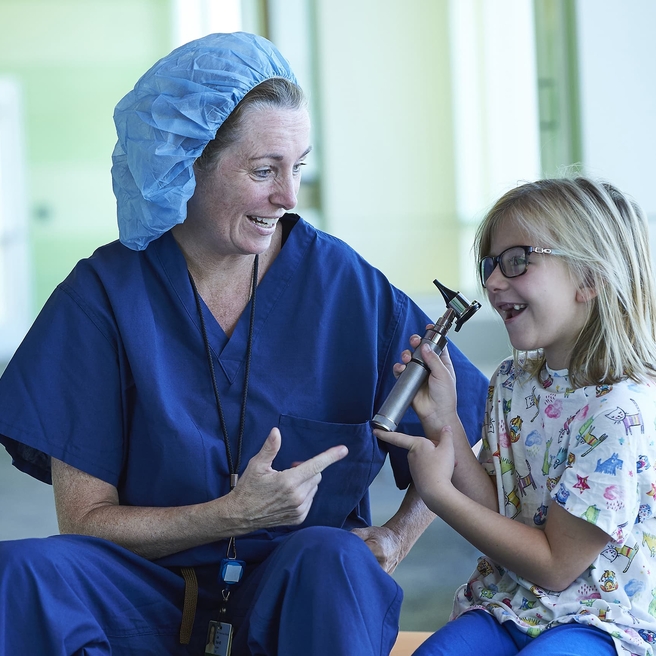What is benign paroxysmal vertigo of childhood (BPVC)?
Benign paroxysmal vertigo of childhood (BPVC) is a common cause of recurrent episodes of dizziness in children. The dizziness episodes are often sudden, last a few seconds to one minute, and children recover completely after the episode, resuming normal play.
The age of onset of BPVC is typically between 3-4 years of age. At this age, children are unable to express symptoms, but will often panic from loss of control and cling to an adult until the episode resolves.
Signs and symptoms of benign paroxysmal vertigo of childhood
Along with dizziness, your child will often have several of the following:
- Nystagmus (fluttering eye movements)
- Ataxia (loss of balance or difficulty walking)
- Vomiting
- Pale appearance
- Fearfulness
- Sweating
- Head tilt
In children with BPVC, there is no impact on hearing. Your child will not lose consciousness during an episode. Symptoms are not provoked by movement.
Cause of benign paroxysmal vertigo of childhood
The specific cause of BPVC is unknown. It is thought to be a precursor to migraines at an older age. Most children with BPVC have a family history of migraines.
Diagnosing benign paroxysmal vertigo of childhood
Your primary care provider will likely refer your child to a pediatric otolaryngologist (ear, nose and throat or ENT specialist) because determining the cause of vertigo can be challenging.
BPVC must be differentiated from other forms of dizziness, and a thorough evaluation of all possible causes may be necessary.
A multidisciplinary team of otolaryngologists, audiologists, and physical therapists is best able to perform the comprehensive evaluation and to know when to call on the expertise of other specialists. The otolaryngology evaluation will include:
- Extensive medical history-taking with questions for both you and your child
- Thorough physical exam, especially of the head and ears
- Vestibular exam to evaluate their balance and inner ear function
During the course of the evaluation, you will meet with a vestibular trained audiologist for an evaluation and further testing. This evaluation may include:
- Audiologic evaluation (hearing test)
- Rotational chair testing, which involves your child sitting in a computerized rotating chair, safely secured with a seatbelt, and wearing light weight goggles. During this test, your child’s eye movements will be recorded as the chair gently moves.
- Videonystagmography (VNG), which involves your child wearing lightweight goggles that have tiny cameras to record eye movements. During the test, your child will be asked to look at a series of objects and their eye movements will be recorded. In another part of the test, warm and cool air or warm and cool water will be placed in your child’s ear canal and their eye movements will be recorded.
- Vestibular Evoked Myogenic Potential (VEMP), which involves gently placing electrode stickers on your child’s forehead, neck, and eyes. Small earphones will also be placed in their ear. The earphones will send clicking sounds to their ear and your child’s body response to the clicking sound will be measured in the electrode stickers.
- Video head impulse test (vHIT) in which your child will wear lightweight goggles that measure eye movements. During the test the audiologist will quickly turn your child’s head and their eye movements will be recorded.
During the course of the evaluation, you will meet with a vestibular trained physical therapist for an evaluation and they may perform tests such as:
- Evaluation of gross motor skills, such as hopping, skipping and jumping with eyes open and closed.
- Dynamic Visual Acuity, which involves testing your child’s vision while your child is shaking their head.
- Posturography, which involves your child will wearing a safety harness and standing on a moving platform to evaluate balance.
Referrals to other specialist may be considered, as well as:
- Lab (blood) tests
- Imaging tests, such as CT scan or MRI
Treatment for benign paroxysmal vertigo of childhood
Although the symptoms of BPVC may be frightening for you and your child, this condition is not considered serious or life-threatening. Treatment involves providing comfort and support to your child during the BPVC episode. The symptoms of BPVC are typically short lived and most children out grow the symptoms within a couple months to a year.
Why choose CHOP?
The Balance and Vestibular Program at Children's Hospital of Philadelphia is a multidisciplinary program that specializes in the evaluation and treatment of children with dizziness and balance disorders. Our program is dedicated to leading the way in the advancement in diagnosis and treatment of pediatric vestibular disorders. Our team is comprised of experts and uses state of the art vestibular testing technology. We work closely with families and referring physicians to better understand a child’s symptoms and create a customized care plan.
Resources to help
Reviewed by Erin W. Field, MMS, PA-C
